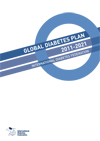A 10-Year Global Diabetes Plan
 In my continuing coverage from the World Diabetes Congress, I thought it may be appropriate to share with my readers the Global Diabetes Plan 2011-2012, recently released by the International Diabetes Federation.
In my continuing coverage from the World Diabetes Congress, I thought it may be appropriate to share with my readers the Global Diabetes Plan 2011-2012, recently released by the International Diabetes Federation.
The objectives of this ambitious plan are to
1) Improve health outcomes of people with diabetes – early diagnosis, cost effective treatment and self-management education can prevent or significantly delay devastating diabetes-related complications and save lives.
2) Prevent the development of type 2 diabetes – lifestyle interventions and socially responsible policies and market interventions within and beyond the health sector can promote healthy nutrition and physical activity and prevent diabetes.
3) Stop discrimination against people with diabetes – people with diabetes can play an important role in their own health outcomes and combating diabetes more generally. Supportive legal and policy frameworks, awareness campaigns and patient-centred services uphold the rights of people with diabetes and prevent discrimination.
The key strategy of the plan is to call on governments to implement National Diabetes Programmes – Comprehensive policy and delivery approaches enhance the organisation, quality and reach of diabetes prevention and care. It is feasible and desirable for all countries to have a national diabetes programme and successful models are already in place in some countries.
The hope is that this strategy will deliver the following results:
1) Strengthen institutional frameworks – strengthen UN and country-level leadership across multiple sectors to ensure coherent, innovative and effective global and national responses to diabetes, and achieve the best possible return on investment.
2) Integrate and optimise human resources and health services – re-orient, equip and build capacity of health systems to respond effectively to the challenge of diabetes through training and workforce devel- opment, particularly at primary care level.
3) Review and streamline supply systems – optimise the provision of essential diabetes medicines and technologies through reliable and transparent procurement and distribution systems.
4) Generate and use research evidence strategically – develop a prioritised research agenda, build research capacity and apply evidence to policy and practice.
5) Monitor, evaluate and communicate outcomes – use health information systems and robust moni- toring and evaluation to assess progress.
6) Allocate appropriate and sustainable domestic and international resources – achieve innovative, sustained and predict- able resourcing for diabetes, including Official Development Assistance (ODA) for low-and middle-income countries.
7) Adopt a whole of society approach – engage governments, the private sector and civil society (including healthcare workers, academia and people with diabetes) in working together to turn the tide on diabetes.
With regard to point 7, the report comes out very much in favour of engaging business and industry in an attempt to encourage:
– property developers to improve building design for physical activity and social inclusion.
– the food industry to support wide availability of nutritious and affordable food and bever- ages, reduce marketing of unhealthy food and to adopt socially responsible business policies and practices.
In fact, this afternoon (too late for this blog post), I will attend a debate on how such interactions with industry could work and perhaps, more specifically, whether or not an organization like the IDF (or for that matter any NGO) should accept funding from industry – including those, who may be deemed to be “part of the problem”.
As the Scientific Director and CEO of the Canadian Obesity Network, Canada’s only national non-profit organization dedicated to obesity prevention and management, which, despite enthusiastic public proclamations by health ministers on their intent to address the obesity problem, currently has no sustainable public funding, this topic is obviously of considerable interest.
I look forward to reporting, on what I hope will be an enlightening debate in tomorrow’s post.
AMS
Dubai, UAE
p.s. a copy of the IDF Global Diabetes Plan is available here
Health Is Not Measured In Pounds
 As anyone watching the news over the past 24 hours will probably have noticed, yesterday saw the release of two large studies looking at whether or not the Edmonton Obesity Staging System is a better predictor of mortality risk than BMI alone – the short answer is “yes”.
As anyone watching the news over the past 24 hours will probably have noticed, yesterday saw the release of two large studies looking at whether or not the Edmonton Obesity Staging System is a better predictor of mortality risk than BMI alone – the short answer is “yes”.
The results from these studies was reported by all major media outlets around the globe including CNN, TIME, MSNBC, and virtually all national print, radio, and tv stations. It was also picked up by the blogsphere.
Interestingly, when I first suggested the use of a staging system for obesity in 2008, it was born out of both a practical need and my own medical experience with obese patients.
The practical need was to better determine, who needs to be seen in our obesity program, given the rather limited resources and long waiting times.
My medical experience had long taught me that the commonly used BMI classification of obesity, or even the suggested use of waist circumference were rather blunt instruments in determining which patients needed obesity treatments and which did not.
So, the idea was simply to create a clinical tool that would help us decide, which obese patients required our attention most urgently.
However, as readers will imagine, with all the talk about ‘healthy” weights and ‘benefits’ of weight loss, our proposal was met with considerable scepticism – not about whether or not obese people with obesity related health problems (EOSS 2-4) needed treatment, but rather whether or not obese people who appeared pretty healthy (EOSS 0/1) were indeed at a low risk from their excess weight.
So we looked for large datasets in which we could apply EOSS and compare it to BMI in predicting death.
In one collaboration, on which my colleague Raj Padwal took the lead, assisted by David Allison and Nicholas Pajewski from the University of Birmingham, Alabama, we looked at the impact of EOSS on mortality in two separate sets of the NHANES study – a representative sample of the US population. The results of this analysis were published yesterday in the Canadian Medical Association Journal.
In another collaboration, on which Jennifer Kuk and Chris Ardern (York University, Toronto) took the lead with help from Timothy Church (Pennington Biomedical Research Center, Baton Rouge, LA), and Xuemi Sui and Steven Blair (University of South Carolina), we looked at the impact of EOSS on mortality in the Aerobics Center Longitudinal Study (n = 29 533). The results were released yesterday in the Applied Physiology, Nutrition & Metabolism.
In today’s post, I will not go into details of the studies or begin a lengthy discussion of the findings – suffice it to say, till someone comes up with an even better way to clinically assess the health status of obese patients, to help decide who does and who does not need obesity treatment, the Edmonton Obesity Staging System may be just the tool that clinicians, payers, and patients have been looking for, to help dispel the notion that health can be measure by simply stepping on a scale.
AMS
Edmonton, Alberta
Psychosis
 Today’s post is another excerpt from “Best Weight: A Practical Guide to Office-Based Weight Management“, recently published by the Canadian Obesity Network.
Today’s post is another excerpt from “Best Weight: A Practical Guide to Office-Based Weight Management“, recently published by the Canadian Obesity Network.
This guide is meant for health professionals dealing with obese clients and is NOT a self-management tool or weight-loss program. However, I assume that even general readers may find some of this material of interest.
PSYCHOSIS
Symptoms suggestive of mania or psychosis need to be investigated and treated before initiating a weight-reduction strategy. Unfortunately, current pharmacotherapy for bipolar disorder (lithium, valproate, olanzapine) and many of the the newer antipsychotics (clozapine, olanzapine, quetiapine) can produce dramatic weight gains. This effect on body weight can exacerbate obesity-related illnesses and hinder compliance with antipsychotic treatment.
There has been some success using topiramate for bipolar and mood disorders both as an independent weight-neutral or even weight-negative mood stabilizer, and as an adjunct to other antipsychotics to decrease iatrogenic weight gain. Lamotrigine may also be considered as a mood stabilizer, and it too has been shown to be weight neutral.
Of all the novel antipsychotics, ziprasidone and aripiprazole have been reported to be nearly weight neutral.
© Copyright 2010 by Dr. Arya M. Sharma and Dr. Yoni Freedhoff. All rights reserved.
The opinions in this book are those of the authors and do not represent those of the Canadian Obesity Network.
Members of the Canadian Obesity Network can download Best Weight for free.
Best Weight is also available at Amazon and Barnes & Nobles (part of the proceeds from all sales go to support the Canadian Obesity Network)
If you have already read Best Weight, please take a few minutes to leave a review on the Amazon or Barnes & Nobles website.
Using Pedometers To Monitor Physical Activity
 Earlier this week I posted on the importance of self-monitoring and asked about how my readers monitor their food and activity – the responses were overwhelming. While almost all readers acknowledged how self-monitoring helped them maintain their weight losses, there was a wide range of tools and programs that were recommended – my response is: whatever works!
Earlier this week I posted on the importance of self-monitoring and asked about how my readers monitor their food and activity – the responses were overwhelming. While almost all readers acknowledged how self-monitoring helped them maintain their weight losses, there was a wide range of tools and programs that were recommended – my response is: whatever works!
While a food journal (electronic or otherwise) works to monitor food intake, keeping track of activity is not quite that easy. While there are sophisticated (and expensive) devices that accurately measure motion in three planes, somtimes even in combination with changes in heart rate, most of my patients tend to use simple pedometers to measure their activity levels.
While measuring steps is probably better than measuring nothing, there are limitations to the use of pedometers.
This topic was extensively discussed in a classic paper by Catrine Tudor-Locke and Lesley Lutes from the Pennington Biomedical Research Center, Baton Rouge, LA, published in Sports Medicine back in 2009.
As the authors point out, two independent meta-analyses concluded that using a pedometer does increase physical activity, probably because it acts as a motivational tool.
In an effort to begin to outline why pedometers work, for whom, and under what conditions, the authors explored the published literature to identify factors related to using pedometers to increase physical activity.
They were particularly interested in the following issues:
(i) gain a better understanding of the activity-promoting characteristics of pedometers;
(ii) determine effective elements of pedometer-based programming;
(iii) identify participants who engage in, and benefit most from, such programming.
From their analysis of the (then) published literature, the authors concluded that pedometers are most sensitive to walking behaviours (both an advantage and a limitation) and offer an affordable and accessible technology that is simplistic in output, low-literacy friendly, and immediately understandable to end-users.
However, they also point out that more research is needed to compare the effectiveness of self-selected individualized goals with tailored goals (based on a specified baseline characteristic, for example), standardized goals (e.g. percentage-based increments) and pre-set uniformly administered goals (i.e. a volume total of 10 000 steps/day or an incremental total of 2000 extra steps/day for everyone).
They also note that since most studies of pedometer-based programmes have been of relatively short duration, it is unknown to what extent observed changes are sustainable or whether it is possible to continue to accrue benefits over long-term adherence.
In addition, the majority of pedometer-based programme participants to date have been women, suggesting that more research is needed on men and how they react to this form of physical activity intervention.
As expected, increases in steps/day are generally the greatest in those who start out with the lowest number of daily steps.
So, while the final verdict is still out on who benefits most, and/or requires additional or alternative strategies to succeed in their personal behaviour-change attempts, current evidence certainly supports the use of pedometers to promote physical activity (irrespective of whether or not this actually results in weight loss).
But pedometers are the simplest devices – I am sure that some of my readers are using more sophisticated equipment?
Also, while recording steps in a diary is certainly effective, I am also sure that many of my readers are probably using propriety software that comes with some of these devices or are entering their steps into online applications.
Looking forward to your responses.
AMS
Berlin, Germany
Tudor-Locke C, & Lutes L (2009). Why do pedometers work?: a reflection upon the factors related to successfully increasing physical activity. Sports medicine (Auckland, N.Z.), 39 (12), 981-93 PMID: 19902981
Injury Patterns in Overweight and Obese High School Athletes
 In case readers are wondering whether the term “obese athlete” is an oxymoron, it is not: from my own practice I know that there are a number of high-performance athletes out there, who can have significant weight-related health problems including obstructive sleep apnea, hypertension and fatty liver disease. But that is NOT the topic of this post!
In case readers are wondering whether the term “obese athlete” is an oxymoron, it is not: from my own practice I know that there are a number of high-performance athletes out there, who can have significant weight-related health problems including obstructive sleep apnea, hypertension and fatty liver disease. But that is NOT the topic of this post!
This post is about the findings of Ellen Yard and Dawn Comstock from the Centre for Injury Research and Policy, Columbus, Ohio, just published in the Journal of Physical Activity and Health, regarding the the relationship between injury pattern and BMI in US high school athletes.
This question is of considerable interest, as the authors note that about one-third of the over 7 million US high school athletes meet the BMI criteria for overweight or obesity.
The researchers analysed data from 100 nationally representative US high schools, which submitted athlete exposure (AE) and injury information during the 2005 to 08 school years via High School RIO (Reporting Information Online).
A total of 13,881 injuries during 5,627,921 athlete-exposures (2.47 injuries per 1000 AE) were reported, representing an estimated 4,339,247 injuries sustained nationally during the 2005–08 school years, for an average of 1,446,416 injuries sustained annually.
Injury rates were higher in competition (4.65 per 1000 AE) compared with practice (1.65 per 1000 AE).
Injury rates were highest in football (4.32 per 1000 AE), wrestling (2.43 per 1000 AE) and girls’ soccer (2.40 per 1000 AE). Injury rates were lowest in baseball (1.13 per 1000 AE), softball (1.19 per 1000 AE), and volleyball (1.39 per 1000 AE).
Two-thirds (61.4%) of these injuries occurred in normal weight athletes, with the exception of football, where 54% of injured athletes were overweight or obese. Specifically, in football, the majority of injured defensive tackles (65.2%), offensive tackles (64.7%), centers (63.1%), and offensive guards (58.4%) were obese.
Sport-specific overweight and obesity prevalence was also high in wrestling (31.7%), baseball (28.6%), and boys’ basketball (19.3%). Conversely, injured girls’ soccer athletes were least likely to be overweight or obese (13.5%). Other sport-specific positions with large proportions of obese athletes included first basemen in baseball (20.5%) and softball (17.2%).
The most common injury diagnoses were incomplete ligament sprains (28.2%), incomplete muscle strains (14.0%), contusions (13.2%), fractures (9.8%), and concussions (9.2%), with one in twenty (5.9%) injured athletes requiring surgery.
Compared with normal weight athletes, obese athletes sustained a larger proportion of knee injuries and their injuries were more likely to have resulted from contact with another person.
Interestingly, compared with normal weight athletes, underweight athletes sustained a larger proportion of fractures and a larger proportion of injuries resulting from ‘illegal’ activity.
With regard to the high prevalence of obesity amongst football players, the authors note:
“Although the use of BMI instead of body fat percentage may have classified some very muscular football players as overweight or obese, these findings are consistent with the previously reported epidemic of overweight and obesity in football. Football culture not only accepts but often encourages large body size, particularly among offensive and defensive linemen.“
These results point to important differences in the pattern of injuries incurred by heavier compared to normal or underweight athletes – some of which may be accounted for by the propensities of heavier athletes to participate in different types of sports than their leaner counterparts.
While this study does not support the notion that higher BMI athletes are at greater risk for injury (reported in previous studies), it may point to an increased risk in underweight athletes:
“With high school athletes being bigger and faster today than in previous years, collisions between mismatched athletes may be putting smaller, underweight athletes at greater risk for severe injury.”
What the paper does not discuss is the long-term risk of athletics for future weight gain, in overweight and obese athletes who retire due to injury or other life events. As blogged before, there seems to be no shortage of patients in my adult bariatric clinic, who report having been competitive athletes in younger years.
AMS
Edmonton, Alberta
Yard E, & Comstock D (2011). Injury Patterns by Body Mass Index in US High School Athletes. Journal of physical activity & health, 8 (2), 182-91 PMID: 21415445



